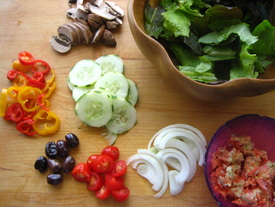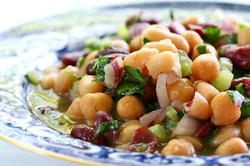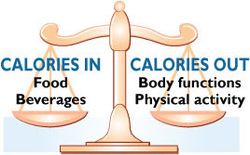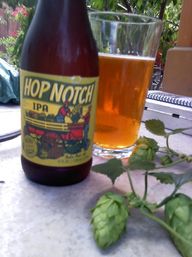 Frequently eating foods prepared away from home is associated with obesity, higher body fat and a higher BMI. It makes sense, doesn't it? Restaurant owners don’t’ care about your pant size or blood pressure, they just want their food to taste delicious and ensure you come back for more. It’s all about that salt, sugar, and fat. Ahh the brain orgasm, or what Michael Moss calls the “bliss point” in his great book. When you cook at home, it’s your hand that’s shaking that salt shaker, putting oil in the pan before you sauté, or sprinkling in that bit of sugar to cut the tartness of your dish. When you cook at home, you control the calories and the flavor. So why don’t we do it more often? Some studies show that the lack of cooking knowledge, confidence, and skills can limit at-home meal preparation. Others explicate our lack of time. Another theory is the drudgery of cooking as many people cook alone, which is a historical exception. Currently we spend an average of 55 minutes per day preparing meals (prepping, cooking, cleaning), down almost 50% since 1965. All the while, most Americans spend up to 5 hours watching TV each day. As Michael Pollan suggests, cooking has become a spectator sport with many of us spending more time watching the Food Network than standing behind our cutting boards. Pollan's new books Cooked by the way is amazing - what a revelation to think that cooking, not nutrient or calorie intake, can quash the epidemic of preventable chronic disease we face. So how do we get folks back into the kitchen? Or at least spending more time cooking meals from scratch rather than relying heavily on packaged and convenience foods (e.g., boxed flavored rice, pasta sauce jars, frozen pizzas), which are faster to prepare yet higher in fat, calories, salt and sugar? PLAN AHEAD. Simplify mealtime by prepping as much as possible ahead of time:
KEEP IT SIMPLE. Go to your local library and pick up a few simple, user-friendly cookbooks. Some quick go-to meals include:
STOCK YOUR KITCHEN: Healthy cooking starts with filling your cupboards. Keep these basics on hand, and you'll be able to whip up delicious meals in less than the time it takes for pizza to be delivered. Basic healthy cooking tools:
USE THE TACO BELL APPROACH: Learn to recombine a few basic ingredients into multiple tasty dishes. PAPER PLATES? If dirty dishes are tempting you to eat out, use paper plates. While I don’t recommend using them for every meal, less cleanup time is a common barrier these help eliminate. I'll leave you with a cute little video where Michael Pollan explains how cooking can change your life.
0 Comments
 We all know the catchy childhood songs about beans: Beans, beans, the magical fruit The more you eat, the more you toot. The more you toot, the better you feel So let's eat beans with every meal! Or Beans, beans, they're good for your heart The more you eat, the more you fart. The more you fart, the better you feel So let's eat beans with every meal! As odd as it sounds, beans are technically a fruit and a recent research study has once again confirmed their being good for your heart. More than just a meat substitute, beans are rich in antioxidants and high in fiber – with one cup of cooked beans (two-thirds of a can) providing about 12 grams of fiber, nearly half our recommended daily dose*. Beyond their contribution of fiber and disease-fighting antioxidants, a diet emphasizing beans (about 1 serving daily) has been shown to significantly lower LDL (low density lipoprotein or "lousy”) cholesterol levels. If you don’t know much about LDL cholesterol, this is good news as high LDL levels are associated with heart disease. If your next physical involves a blood test, a LDL of less than 100 milligrams per deciliter (mg/dL) is optimal. If your LDL levels are high, watch your intake of saturated fats and ensure to get enough fiber. Regular aerobic exercise also lowers LDL cholesterol and increases HDL (high density lipoproteins or "good") cholesterol to boot. Alrighty then, whose ready for some hummus and veggies? Easy ways to boost your bean intake:
*Dietary Fiber requirements for healthy adult males is 38gm/day, and 25 gm/day for adult females.  To maintain your weight, you have to balance your calories. There is some debate to this calories in, calories out mantra*, but for those new to the land of weight loss and weight maintenance the calorie balance mantra is a great platform to start. So...calories. We've all heard of them, but what are they? Well, a calorie is a just unit of energy. We tend to associate calories with food, but they apply to anything containing energy. A calorie is the amount of energy, or heat, it takes to raise the temperature of 1 gram of water 1 degree Celsius. We humans need energy to survive -- to breathe, move, pump blood, and think -- and we get this energy from food and beverages. We also burn energy, or calories, during physical activity. We all come in different shapes and sizes and each person's body burns energy (calories) at different rates, so there isn't one perfect number of calories we should eat. However, the recommended range for most adults is between 1,600 to 2,800 calories per day, depending on your age, sex, and activity level. If you are maintaining your current body weight, you are in caloric balance. If you need to gain weight or to lose weight, you'll need to tip the balance scale in one direction or another to achieve your goal. If you need to tip the balance scale in the direction of losing weight, keep in mind that 1 pound of body fat is approximately 3,500 calories – so you’ll have to eat that much less or burn that many more through exercise (ideally a combination of both!) to lose 1 pound. To lose about 1 to 2 pounds per week, you'll need to reduce your caloric intake by 500—1000 calories per day. To learn how many calories you are currently eating, begin by reading your nutrition labels and write down the foods and beverages you consume each day as well as the type and duration of your physical activities (cleaning the house counts!). By writing down what you eat and drink, you are incorporating awareness into your day. As I wrote in a prior post, journaling counts! A recent study revealed that people keeping a food diary six days a week lost about twice as much weight as those who kept food records one day a week or less. In addition, experiment tracking when and where you eat and what emotions you experience to beat emotional eating. *Is a calorie a calorie regardless of its source ( carbohydrates, fats, sugars, or proteins, etc.)? I will get into this in a future post. Spoiler alert: some researchers believe that not all calories are created equal.  Attention Restoration Theory (ART) asserts that people can concentrate better after spending time in nature, or even looking at scenes of nature. Time in nature seems to help restore our prefrontal cortex, the thick outer layer of our brain that is in charge of planning, decision making, and moderating social behavior, which can become depleted with overuse. Studies have found that ART can enhance cognitive function. One study in particular found that found that after four days of immersion in nature, and the consequent disconnection from technology, subjects experienced increased performance on creativity and problem-solving tasks. Of course, not all of us have the time to immerse ourselves in nature for four entire days. Luckily, just twenty minutes in a park setting is sufficient to elevate attention performance relative to the same amount of time in other settings. The variety of research on ART indicate that our environments can enhance attention and that “doses of nature” might even serve as a safe, inexpensive, and accessible tool for those managing ADHD symptoms. Many researchers believe that humans are dependent on nature not only for material needs (food, water, shelter, etc.) but perhaps more importantly for psychological, emotional, and spiritual needs. Natural places such as parks offer an opportunity to become revitalized and refreshed while urban areas often mean dealing with environmental demands such as crowds, noise, and pollution. It has been demonstrated that these factors can cause mental fatigue and exhaustion. I had the good fortune to get a little dose of ART on my birthday weekend, hiking 12 miles in the Philip Burton Wilderness on the Point Reyes Peninsula with my girlfriend Sara. We in the Bay Area are beyond fortunate to have such lush coastal trails and wildflower-filled meadows within a few hours drive. We enjoyed snacking on sweet wild strawberries, smelling the soapy Ceanothus and evading the poison oak and stinging nettle. With regard to ART, there is something to be said about multi-day treks in the wilderness, where your to-do's and distracting electronic devices are left at home. A two night, three day backpacking trip to the Trinity Alps is brewing here. 'Till then, let's keep incorporating daily doses of scenic beauty. Not only will be receive cognitive advantages, but we'll also get a dose of Vitamin D, exercise, fresh air and happiness.  I spent last weekend in Boonville for their annual campathon and beer fest so figured I would write a post on the health benefits of beer. Before my short stint at the Bistro in Hayward, I was unaware of the delicious variety of beer and its warm community. In October of 2008 I worked at their annual wet hop festival and it forever elevated my palate to the IPA-loving woman I am today. Moylan’s Wet Hopsickle was the drink that sealed the deal for me. I love beer for its delicate balance of sweet malt and bitter, fragrant hops, but knowing its health benefits* sure help justify my imbibing: Beer and your bones Beer is rich in silicon, a trace element that plays an important role in bone formation, bone density and connective tissue health. During the mashing process, silicon is made readily bioavailable. Other dietary sources of silicon include whole grains, fruits and vegetables such as green beans and bananas, and legumes. Fiber Beer and fiber? Made from barley, beer contains beta-glucans — a type of soluble fiber credited with improving heart health by lowering cholesterol levels. A 12 ounce bottle of lager sports 0.75 grams of fiber while the same amount of dark beer boasts 1.3 grams. It’s vitamin B-licious Beer is an excellent source of B vitamins such as folate, niacin, riboflavin, pantothenic acid, B6 and B12. One 12-ounce beer supplies 3% of the B12 and 12.5% of the B6 you need in a day. These nutrients support your body’s metabolism and help it produce essential substances, such as neurotransmitters and red blood cells. Heart healthy Those who drink one to two alcoholic drinks of any kind are less likely to suffer from heart disease. Experts believe alcohol improves heart health by making blood less “sticky” so it's less likely to clot by increasing levels of good HDL cholesterol while lowering unhealthy LDL cholesterol. Hops fight cancer Hops are an acquired taste for some, but reconsider their bitterness and in return get a dose of cancer-fighting antioxidants! Hops contain the flavonoid compound called xanthohumol that has interesting cancer chemopreventive properties (i.e it inhibits, reverses or retards tumor growth). I will leave you with the Oatmeal’s 20 things worth knowing about beer. Gotta love this comic. *Most of these health benefits pertain to moderate drinking, 1-2 drinks per day. Beer's calories and carbohydrates also pose a dilemma for those striving to manage their weight. The average light beer has about 110 calories per bottle while a pint of flavorful craft beer can have up to 250. But how much flavor are you willing to sacrifice to save a few calories? In my opinion, life is too short for crappy beer. Drink mindfully, keep active, get enough sleep and don’t stress about it. More on managing calories in another post.  I am off for my lunch hour walk. Some days I drag my feet, but knowing how I’ll feel once I return to the office gets me out (more on exercise and mood soon). In addition I have to keep accountable to my lunchtime walking partners (thank you Leslie and Teresa)! If you haven’t heard yet, “sitting is the new smoking”. Sitting and smoking you ask? Well, research is beginning to equate sitting to smoking in terms of harm to overall health. A 2012 study analyzing the results of 18 studies with a total of nearly 800,000 participants found that higher levels of sedentary behavior were associated with a 112% increase in the risk of diabetes, 147% increase in the risk of cardiovascular disease, 90% increase in the risk of cardiovascular mortality and 49% increase in the risk of all cause mortality. Prolonged sitting is not what nature intended for us, yet it’s become the norm. Sitting in the car or in public transportation, sitting in front of a computer at work, sitting in meetings, sitting in front of the TV….the average American spends an average of 7.7 hours sitting each day. So how can we fight this sitting disease? Here are some thoughts: · Get off the bus or train a stop early · Take the stairs · Set up walking meetings at work and hiking dates with family and friends · Set up reminders to walk at lunch or during breaks · Walk or stand while on the phone · Get a pedometer and count your steps (research shows that those who wear pedometers walk up to 2,000 more steps each day than non-wearers!) · Start incorporating post-meal walks (which are effective at lowering the glycemic impact for those managing their blood sugar) · Choose a parking spot that's far from the store entrance -- or just walk to the store · Get a dog (dog owners take approximately 25% more steps per day than non-owners) However you choose to fight the sitting the disease, whether it's during the work day, before or after, it should match your personal tastes and limitations. The American College of Sports Medicine recommends that healthy adults walk or exercise aerobically at a moderate pace* at least 150 minutes or at a vigorous pace at least 90 minutes a week. They also recommend adding resistance and flexibility training 2 to 3 times a week. This might be too much to start. An initial goal of walking 15 minutes 3 times a week will benefit you in the beginning and leave plenty of room for you to increase the duration as your mood and energy improve. Alrighty then, I'm outta here. As the father of modern medicine, Hippocrates, said, “walking is man’s best medicine.” Let’s all start taking his advice today. * You'll know its moderate by taking the “talk test” — you should be able to talk while working out, but not sing. |
AuthorHello and welcome! My name is Andrea Notch Mayzeles. I am a Certified Health Education Specialist, Mom, and Master of Public Health dedicated to the path of well-being. As a wellness professional I am committed to continued learning and am here to share research, recipes and musings on health, psychology, personal development, and parenting. I hope you enjoy! Categories
All
|

 RSS Feed
RSS Feed